 |
Previous part (previous style)
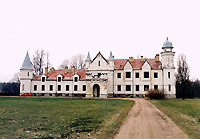 By the 1840s and 1850s, the period of strict
Classicist
forms was over and architects started to use details of all historical architectural styles (Romanesque, gothic, renaissance, baroque, classicism) at the same time or then tried to imitate a specific historical style. This period is called Historicism. A building where a specific historical style (eg. gothic style) has predominantly been used and other styles have mostly been avoided is also called a neo or pseudo style (eg. Neo-Gothic or pseudo-Gothic) building. A building where several styles have been imitated can fall into different categories.
By the 1840s and 1850s, the period of strict
Classicist
forms was over and architects started to use details of all historical architectural styles (Romanesque, gothic, renaissance, baroque, classicism) at the same time or then tried to imitate a specific historical style. This period is called Historicism. A building where a specific historical style (eg. gothic style) has predominantly been used and other styles have mostly been avoided is also called a neo or pseudo style (eg. Neo-Gothic or pseudo-Gothic) building. A building where several styles have been imitated can fall into different categories.
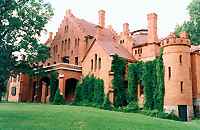 In the Estonian manorial architecture, the period of Historicism or Neo styles lasted until World War I. During that period, many new manor houses were built and even more were reconstructed. The majority of Estonian manors have some elements or parts dating back to that period.
In the Estonian manorial architecture, the period of Historicism or Neo styles lasted until World War I. During that period, many new manor houses were built and even more were reconstructed. The majority of Estonian manors have some elements or parts dating back to that period.
Preserved examples of Neo-Gothic manor houses:
Keila-Joa,
Vasalemma,
Laitse,
Alu,
Lehtse (in ruins),
Lööne,
Pihtla (in ruins),
Lustivere,
Kukulinna (Tudor style),
 Alatskivi (imitation of the Balmoral castle in Scotland),
Sangaste,
Aavere (in ruins),
the burial chapel of Kose-Uuemõisa manor (in ruins),
the burial chapel of Esna manor,
the burial chapel of Velise manor,
the burial chapel of Kabala manor (in ruins).
Alatskivi (imitation of the Balmoral castle in Scotland),
Sangaste,
Aavere (in ruins),
the burial chapel of Kose-Uuemõisa manor (in ruins),
the burial chapel of Esna manor,
the burial chapel of Velise manor,
the burial chapel of Kabala manor (in ruins).
Preserved examples of Neo-Renaissance manor houses:
Arkna,
Inju,
Puurmani,
Avanduse,
Raadi (in ruins),
Muraste (in ruins),
Saka,
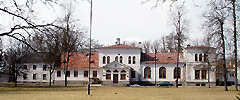 Muuga,
Käru (preserved in rebuilt form),
Viljandi,
Laimetsa (in ruins),
Ulvi (extension),
Harku (mainly the facade),
Kaagjärve (later rebuilt).
Muuga,
Käru (preserved in rebuilt form),
Viljandi,
Laimetsa (in ruins),
Ulvi (extension),
Harku (mainly the facade),
Kaagjärve (later rebuilt).
Examples of preserved Neo-Baroque manor houses:
Ravila (restored after the 1905 arson in historicistic form),
Laupa,
Halinga (with some Heimat style elements),
Järvere,
Kärstna.
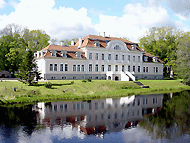 Examples of preserved Neo-Classicist manor houses:
Kumna manor new main building,
Sooniste (restored after the 1905 arson in Neo-Classicist form)
Seli and
the extension of Kõima manor house.
Examples of preserved Neo-Classicist manor houses:
Kumna manor new main building,
Sooniste (restored after the 1905 arson in Neo-Classicist form)
Seli and
the extension of Kõima manor house.
Examples of other preserved majestic historicist manor houses the specific Neo style of which is hard to define:
Kehtna,
Kiviloo,
Kose-Uuemõisa,
Kohala,
Malla,
Veltsi,
Eivere,
Jäneda,
Kolu (Järvamaal),
Ungru (in ruins),
Pädaste,
Kõljala,
Olustvere,
Pärsti,
Kulina,
Roodevälja,
Sänna,
Võidula,
Kõltsu,
Heimtali,
Laeva,
Uderna,
Hummuli,
Sõmerpalu,
Luutsniku.
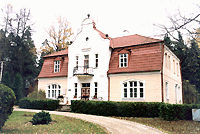
Next part (next style)
|
 |











